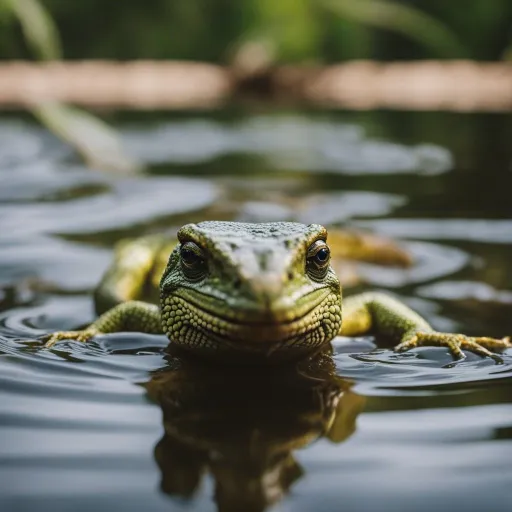Imagine you’re out exploring in the wilderness, and suddenly you come across a lizard basking in the sun.
You marvel at its vibrant colors and swift movements, but then a question pops into your mind: where do lizards go to sleep?
After all, they can’t just tuck themselves into a cozy bed like we humans. In this article, we will unravel the mystery of where these scaly creatures find their nightly repose, delving into the fascinating world of lizard slumber.
So, let’s embark on this nocturnal adventure and discover the secret sleeping habits of these elusive reptiles.
Lizards typically sleep in safe, hidden places within their natural environment, such as under rocks, inside tree hollows, or within dense foliage to protect themselves from predators. The specific location varies depending on the species and their habitat, ranging from deserts and forests to urban areas where they might find refuge in crevices or under structures.
Habitat and Lizards’ Natural Environment
Lizards’ preferred habitats
Lizards can be found in a wide variety of habitats across the globe. Depending on the species, they may prefer forests, deserts, grasslands, or even urban areas.
These diverse environments provide lizards with different resources and shelter options.
Variety of environments
Lizards have adapted to thrive in a range of environments, each with its own unique characteristics.
Some lizards are well-suited for the arid desert landscapes, while others excel in the dense vegetation of tropical rainforests.
This adaptability allows lizards to occupy various habitats worldwide.
Shelter options in different habitats
In their natural environments, lizards find shelter in various ways. For desert-dwelling lizards, burrowing and hiding beneath rocks provide protection from extreme temperatures.
Tree-dwelling lizards rely on branches and leaves to hide from predators and seek shelter. Lizards in rocky areas often use crevices and gaps to take refuge and sleep.
The availability of these different shelter options in different habitats caters to the diverse needs of these reptiles.
Diurnal and Nocturnal Lizards
Differences between diurnal and nocturnal lizards

Lizards exhibit different activity patterns, with some being active during the day (diurnal) and others being active during the night (nocturnal).
Diurnal lizards are more commonly observed because their active hours align with our daylight cycle, while nocturnal lizards are often overlooked by humans.
Sleeping habits of diurnal lizards
Diurnal lizards tend to sleep during the night. They usually find shelter in crevices, under rocks, or even in tree hollows, where they can feel secure.
These sleeping locations provide protection from predators and help regulate their body temperature.
Sleeping habits of nocturnal lizards
Nocturnal lizards, on the other hand, are awake and active during the night. During the day, they seek shelter in burrows, under rocks, or in dense vegetation.
These hiding spots provide them with a safe place to rest and conserve energy for their nighttime activities.
Sleeping Crested Gecko
Crested gecko’s unique sleeping habits
The crested gecko, a popular pet lizard, has some distinctive sleeping habits. Unlike many other lizards, it is primarily nocturnal.
It spends its days resting in hidden locations and becomes active at night. This behavior reflects its natural adaptation to the dark forests of New Caledonia, its native habitat.
Crested gecko’s preferred sleeping locations
Crested geckos prefer sleeping off the ground. They often rest on branches, in tree hollows, or on vertical surfaces such as the sides of their enclosure.
This arboreal sleeping preference mimics their natural habitat and helps them feel secure.
Sleeping behavior during the day and night
During the day, the crested gecko remains mostly stationary, relying on its excellent camouflage to blend in with its surroundings.
At night, it becomes more active, hunting for food and exploring its environment. This nocturnal lifestyle is a fascinating characteristic of this unique lizard species.
Desert Dwelling Lizards
Adaptations of desert-dwelling lizards
Desert-dwelling lizards have evolved remarkable adaptations to survive in arid environments.
Their scales are often thick and covered with a protective layer to minimize water loss.
They also have the ability to change their body orientation to reduce exposure to the sun, limiting heat absorption.
Burrowing as a sleeping strategy
To escape the harsh desert heat during the day, many desert lizards resort to burrowing. They dig into the cool sand, creating elaborate underground tunnels and chambers.
These burrows serve as both a refuge from predators and a sheltered spot to sleep during the scorching daylight hours.
Utilizing rocks and crevices for shelter
In addition to burrowing, desert-dwelling lizards also take advantage of rocks and crevices found in their habitat.
These natural structures provide a cool and shaded spot for lizards to hide and sleep. By utilizing the natural features of the desert landscape, these lizards increase their chances of survival.

Tree-Dwelling Lizards
Benefits of sleeping in trees
Tree-dwelling lizards have several advantages over their ground-dwelling counterparts. Sleeping in trees provides them with protection from ground-dwelling predators, as well as a better vantage point to spot potential threats.
It also allows them to escape unfavorable ground conditions and find a safe place to rest.
Canopy or trunk preferences
Some tree-dwelling lizards prefer to sleep on the branches and leaves of the tree canopy, while others find comfort in sleeping closer to the trunk.
These different preferences may depend on factors such as temperature regulation, shelter from wind or rain, and camouflage from predators.
Each species finds its own optimal sleeping spot within the tree.
Tree-dwelling species example: Anole lizards
Anole lizards, known for their ability to change color, are a prime example of tree-dwelling lizards.
They have specialized toe pads that allow them to cling to tree bark, enabling them to sleep on vertical surfaces.
Anoles often choose sleeping spots near the edge of leaves, where they can blend in and remain hidden from predators.
Burrowing Lizards
Sleeping underground
Burrowing lizards spend a significant amount of time underground, including during their sleeping hours. They dig complex systems of burrows, which provide them with protection from extreme temperatures, predators, and inclement weather. These burrows create a safe and stable environment for their slumber.
Construction of burrows
The construction of these burrows varies among different species of burrowing lizards.
Some lizards dig deep tunnels with multiple chambers, while others create simpler networks of interconnected burrows.
The complexity of the burrow system depends on factors such as the lizard’s size, habitat, and its need for protection and thermoregulation.
Examples of burrowing lizards
Examples of burrowing lizards include the Gila monster and various species of skinks.
These lizards have evolved to excel in their subterranean lifestyle, using burrows not only for protection during sleep but also for hunting and rearing offspring.
Burrowing is an essential adaptation that ensures their survival in their respective habitats.
Rock and Crevices Lizards
Utilizing rocks and crevices for shelter and sleeping
Many lizard species prefer sleeping in the safety of rocks and crevices. These natural structures provide protection from predators by acting as a barrier and providing hiding spots.
Lizards can wedge themselves into tight crevices or find comfortable nooks to curl up and rest undisturbed.
Camouflage and protection benefits
Sleeping among rocks and crevices also offers camouflage advantages for lizards. Their natural colors and patterns blend seamlessly with the rocky backdrop, making them less conspicuous to predators.
By utilizing these strategic sleeping locations, lizards enhance their chances of survival.
Rock-loving species example: Collared lizards
Collared lizards are known for their affinity for rocky areas. They often choose to sleep on boulders or perch themselves on elevated rock formations.
These visual displays not only serve as a means of communication but also provide them with a prime spot to bask in the sun or rest under shade during their sleeping hours.
Lizards’ Sleeping Patterns
Periods of inactivity
Lizards, like many other animals, experience periods of inactivity during their sleep. While the duration and frequency of these inactive periods vary among species, lizards generally enter shorter bouts of rest throughout the day or night, depending on their diurnal or nocturnal nature.
Torpor and hibernation
Some lizard species, particularly those in colder climates, undergo torpor or hibernation during the winter months.
Torpor is a state of decreased activity and metabolism, allowing lizards to conserve energy when resources become scarce.
This adaptation enables them to survive harsh weather conditions and lack of food.
Phases of sleep
Similar to other vertebrates, lizards experience multiple phases of sleep. These include non-rapid eye movement (NREM) sleep, rapid eye movement (REM) sleep, and slow-wave sleep.
Each phase serves a different purpose, such as rest and recovery, memory consolidation, and dreaming-like brain activity.
Sleeping in Groups
Social sleeping behavior
Some lizard species exhibit social sleeping behavior, where multiple individuals aggregate in the same sleeping area.
This behavior, known as communal sleeping, promotes thermoregulation, predator detection, and social bonding among group members.
Congregating in communal sleeping sites
Communal sleeping sites can vary depending on the lizard species. Large rocks, tree hollows, or even underground burrows may serve as gathering spots.
By sleeping in groups, lizards can share body heat and provide an extra layer of protection by watching out for each other during vulnerable sleep periods.
Protection and thermoregulation benefits
Group sleeping in lizards offers various advantages. The combined body heat of multiple individuals helps maintain an optimal temperature in colder environments.
Additionally, the collective vigilance of the group helps to detect predators more effectively, minimizing the risk to each individual lizard.
Human Interaction and Sleeping Lizards
Effect of human activity on lizard sleep
Human activity can significantly impact lizard sleep patterns. Noise, disturbance, and artificial lighting can disrupt their natural sleeping rhythms, making it harder for them to find restful sleep.
Urbanization and habitat destruction may also restrict their access to suitable sleeping locations, forcing them to adapt to less optimal conditions.
Lizards as pets – Sleeping arrangements
When kept as pets, lizards need suitable sleeping arrangements to mimic their natural environment.
Providing appropriate hiding spots, such as caves, hollow logs, or simulated burrows, allows them to feel secure and rest undisturbed.
It is crucial for pet owners to create a conducive sleeping environment for their lizards’ well-being.
Sleep disturbances caused by human presence
The presence of humans, particularly during the nocturnal hours, can disturb lizards’ sleep. Bright lights, loud noises, and handling can all interrupt their sleep patterns and cause stress.
It is essential to respect their need for rest and create a quiet, dimly lit space for them to sleep peacefully.
Final Thoughts
In conclusion, lizards exhibit various sleeping habits and preferences depending on their species and natural environments.
From desert burrows to tree branches, rocks to tree trunks, these resilient reptiles have adapted to take advantage of different sleeping locations.
Understanding their sleeping patterns and providing suitable conditions, whether in the wild or as pets, allows us to appreciate and respect these fascinating creatures’ needs.
Frequently Asked Questions
Q: Where do lizards go to sleep at night?
A: Lizards typically seek shelter in crevices, under rocks, in tree bark, or burrows to sleep at night, where they are protected from predators and the elements.
Q: Where do lizards sleep during the day?
A: Most lizards are diurnal and active during the day but may take short naps in shaded areas or their night-time hiding spots to rest.
Q: Where do lizards sleep in California?
A: In California, lizards often sleep in natural shelters like underbrush, rock piles, and logs, adapting to the diverse habitats ranging from deserts to forests.
Q: Where do lizards sleep in Florida?
A: In Florida’s humid climate, lizards may sleep in dense vegetation, under rocks, in tree trunks, or even in human-made structures offering protection.
Q: What time do lizards go to bed?
A: Lizards do not have a specific “bedtime” but generally become inactive and seek their sleeping spots at dusk when temperatures drop and their activity decreases.
Q: Where do lizards sleep in the winter?
A: During winter, lizards often hibernate or brumate in protected spots like deep rock crevices, burrows, or under leaf litter to stay safe from cold temperatures.
Q: Do lizards sleep with their eyes open?
A: Most lizards can close their eyelids and likely sleep with their eyes closed. Some species may rest with their eyes slightly open if they feel insecure or are in a new environment.
Q: Do lizards sleep on walls?
A: Yes, some lizard species, especially those that are adept climbers like geckos, may sleep on walls, particularly in warmer climates or within buildings.




